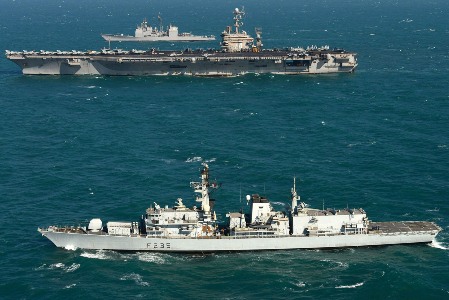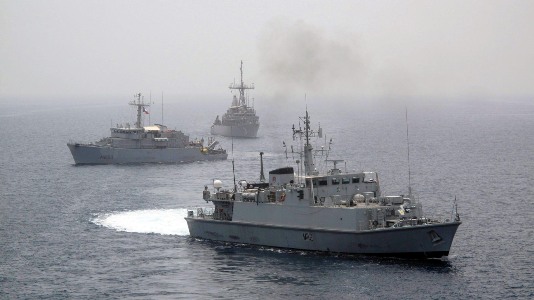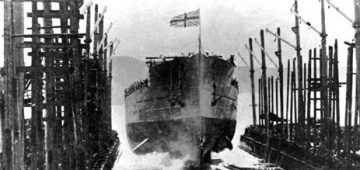by Francis Beaufort

The Royal Navy’s destroyers and frigates are maids of all work, indeed ubiquitous on the seven seas. And let’s not forget the survey vessels that hardly ever see their home bases, the hunter-killer submarines on patrol for almost a year at a time.
Then there are the aviation units forward-deployed East of Suez for years and Royal Marines embarked in the amphibious vessels for long-distance deployments. The Royal Marines were also for several years engaged in combat with the Taliban in far away, landlocked Afghanistan.
The young men and women of the Naval Service are fine ambassadors for Britain in virtually everything they do. They have in recent times delivered humanitarian aid and disaster relief to the people of the Philippines, pursued pirates in the Gulf of Aden, bombarded regime targets in Libya and cleared mines to allow hospital ships safe passage to besieged ports. In the latter two cases the RN’s men and women were at considerable risk from the foe’s gunnery.
Meanwhile, as every ounce of utility and capability is squeezed out of both people and equipment – working hard out of sight and out of mind in the far-flung corners of the world – back home in the UK the Navy’s footprint shrinks. Bases contract, while England’s last shipbuilding yard is to be closed. New orders for support vessels are awarded to overseas companies instead of sustaining British yards.
Milestone anniversaries for famous naval battles in WW2 pass unremarked, or the media instead brings into focus defeats – such as Convoy PQ17 or the loss of HMS Hood – rather than triumphs, such as the Taranto raid or the pursuit and destruction of Bismarck.
The Army dominates the headlines due to its exploits in Afghanistan. The roles of sailors and marines on the front line are rarely noticed in the shadow of brave squaddies and a cavalry officer prince flying attack helicopters. The Royal Air Force never fails to maximise the PR benefit of the Red Arrows, of having a future King flying its own helicopters, or tap into the deep well of enduring interest in the Dambusters raid and Battle of Britain.
The RN’s big show of the past decade – the Trafalgar 200 International Fleet Review at Portsmouth – was virtually ignored by the BBC, which only realised it should have given the spectacular event blanket coverage when two million people turned out to watch the IFR from the shores of the Solent. This was just a blip, for across the national media and in British society as a whole there is the much lamented, so-called Sea Blindness.
But the Navy’s cause isn’t helped by its failure to give its friends more support and help in their barely recognised efforts to spread the message. It is a reticent Senior Service that distrusts the media, indeed seems to fear it, worrying about how its reputation might be sullied, yet shying away from exploiting its amazing history to show its current relevance and inspire people. It fears appearing old-fashioned or triumphalist, yet this never seems to bother the Army or the RAF.
Worst of all, these days the Navy cloaks much of what it does have to say in utterly alienating corporate speak that no normal person could possibly relate to. The Naval Case the corporate speak tries clumsily to convey is not helped by the deeply controversial nature of some major issues, such as the future carrier programme and plans to build new generation ballistic missile submarines.
Such multibillion pound investment requires clear, concise messaging explaining to a nation buckling under the strain of recession why the cost is so worth it: To safeguard the UK, its global interests and international security for decades to come.
The UK’s politicians are similarly incapable of explaining worth over cost, falling prey to strategic incoherence and muddled geo-political dogma about the UK becoming an aid superpower (this in an increasingly risky era of naval hard power). There are few voices at a national level visibly making the Naval Case in open political debate.
Admiral Lord West is one who tries, pressing on regardless of some who might prefer he maintains the Omerta of the Silent Service (even if such silence risks condemning the Navy to extinction). The former First Sea Lord recently asked in the House of Lords if Britain’s future warship building plans are enough to meet its global defence needs.
“Have we really decided that this great maritime nation of ours needs only 13 frigates?” Lord West asked during a recent defence debate. “Only four years ago, 18 was considered too risky; at the time of the Falklands, we had 40. Has there been a realistic, in-depth study of the requirement for the number of frigates – I am talking about frigates, not destroyers or other things – or is the number 13 based purely on an arbitrary cost figure? In the final analysis, defence of the nation is the top priority for any Government of whatever hue, and I believe that we are standing into danger.”
Lord Astor of Hever, answering for the government, decided to dodge the issue of whether or not force levels had been adequately analysed. “My Lords, I agree with the noble Lord that defence of the nation is absolutely the top priority of the Government,” said Lord Astor. “That is why we are undertaking the Type 26 global combat ship programme. The Type 26 will become the backbone of the Royal Navy from around 2020, and the programme will help sustain surface warship capability in the United Kingdom after the construction of the carriers. This multibillion-pound investment will secure thousands of skilled shipbuilding jobs across the UK for decades to come.”
It was an amazingly bland response; bearing in mind the man who posed the question on warship numbers was a former uniformed leader of the Royal Navy.
Lord Clive Solely decided to pin Lord Astor down on Lord West’s question. “The Minister has just described the Type 26 as the backbone of the Royal Navy,” Lord Solely observed. “The problem is that there are only 13 of them, and there does not seem to be any planning beyond that. I think that most of us are concerned about the long-term view of the Royal Navy for us as a maritime power, as was indicated in the first Question. Thirteen is not the backbone of a major maritime power.”
Lord Astor again dodged the numbers issue and gave an answer, which was heavy on bluster and sound bites but light on detail. “My Lords, I disagree with the noble Lord. The [current] First Sea Lord has some very exciting plans for the future of the Royal Navy. The Type 26s we are planning, the three OPVs and, of course, the Type 45s which my noble friend mentioned, are all part of those exciting plans.”
The minister of course would not want to get into a force levels debate as 13 new Type 26s constructed between now and the 2030s provides very little work for British shipyards, and means Type 23 frigates have to sail on well past their sell-by date. It will cost huge amounts of taxpayers’ money to keep such ships (conceived in the 1980s) operational into the 2030s. The Type 23s will also become increasingly unreliable as time and operations wear them down.
A baker’s dozen Type 26s actually equates to just four warships being available for operations at any one time (and that does not take into account losses due to peacetime wear and tear or combat casualties).
But the House of Lords exchange outlined above is what in Britain today passes for serious debate on the Royal Navy. Across London the Chief of the Defence Staff (CDS), an army general, made a very clever speech that primarily undermined ring-fencing of even the current very modest future warship construction plans. It was a masterful piece of work. The First Sea Lord was so perturbed by the CDS giving the wrong impression he felt moved to issue a statement reassuring the Nation that the Navy would indeed be able to man and operate future warships properly.
The British armed forces have not seen a naval CDS for more than a decade – an RAF officer and two Army generals have steered the British military since 2003. The current generation of top politicians in the UK seems to lack any useful insight into geo-strategic naval matters. The national media are either Army barmy or display only lightweight maritime intellect. The general public is seldom touched by the sea or believes that sailors and marines it sees in action are part of the RAF or Army.
Even when sailors and Royal Marines were sent to aid flood-stricken communities in the south of England this month (Feb) they were described by several on-the-spot news reporters as being from the Army. That fact that the sailors wore dark blue uniforms did not seem to alter the perspective that it is always the Army that helps. Someone must have eventually told the television companies to get their facts straight as the news broadcast anchors in TV studios did start to mention the Navy. Bravo Zulu to whoever made that call.
Yet it is all too easy to feel that no matter how valiant the globally deployed RN is – redoubling its efforts under the strain of scarcer resources – it has lost the battle on the home front. While the issue of its cost is sometimes debated (and criticised) its worth is not often appreciated (or praised).
The fight on the home front requires more plain speaking from the Navy, more confidence in the full scope of its story – past, present and future – and being less frosty towards its real friends, while not failing to recognise its foes need to be comprehensively outwitted (or educated into submission).
Pictured Above:
On the far away front line working alongside the UK’s principal geo-political partner in the Middle East: The Duke Class (Type 23) frigate HMS Monmouth underway with the American aircraft carrier USS John C. Stennis and the cruiser USS Mobile Bay. Photo: US Navy.

Royal Navy leading the way on the global front line: Ships break formation during an International Mine Counter-measures Exercise (IMCMEX) in the Gulf, with the Sandown Class mine-hunter HMS Shoreham in the lead.
Photo: US Navy.






Comments
Sorry, comments are closed for this item